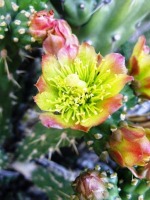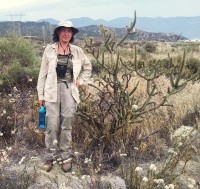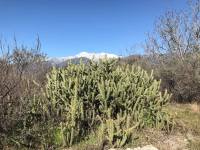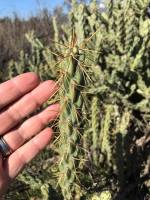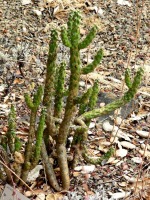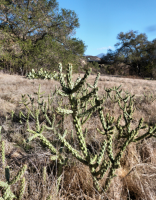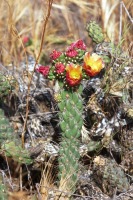Actual citation: Cereus californicus Torr. & A.Gray, Fl. N. Amer. (Torr. & A. Gray) 1(4): 555 (1840).
Citation that is sometimes used. Engelmann. 1848. Notes of a Military Reconnaissance 2: 158.
Neotype; Herbarium specimen; Herbarium specimen; Herbarium specimen (Isotype; submitted as G. californica var. delgadilloana); Herbarium specimen (Lectotype; submitted as G. californica var. parkeri); Drawing (Britton and Rose, 1919 v1)
The original description may be: G. californicus (unvalidated and provisional),
Flora of North America treatment
What is Cylindropuntia californica?
Cylindropuntia californica is a cholla found in coastal sage scrub and chaparral habitats of extreme southern-central CA and Baja California.
Details
The species has two varieties: G. californica var. californica and G. californica var. parkeri. (Note: Recent studies have determined that G. c. var. parkeri is correctly named G. bernardina. Otherwise, all information on this page is correct). Both varieties have firmly attached stems 6 to 30 cm long by 1.5 to 2.5 cm wide with 0 to 20 yellow to brown spines which rarely obscure the stem. The spines age dark grey and the sheaths are white, yellow, or brown. Flowers are yellow, often with red tips. The filaments are green or yellow, the styles are light green to cream, and the stigmas are cream to yellow. The fruits are green to yellow, leathery to dry, with few to no spines.
G. californica var. parkeri is the more common variety. It is an erect shrub growing to 2 m tall and occurring mainly in chaparral, oak scrub, juniper woodlands, plains, and hills of the Transverse and Peninsular mountain ranges of southern California and their intervening valleys. The central spines of this variety are generally noticeably longer than the radial spines (1.5 to 3 cm).
G. californica var. californica is a rare taxon, although it is not state or federally listed. The California Native Plant Society gives this species its highest Rare Plant Rank, 1B.1, indicating that it is “rare, threatened, or endangered in California and elsewhere.” It is restricted to the coastal regions of San Diego County and Baja California. It is relatively easily distinguished from G. c. var. parkeri by its decumbent, sprawling habit, which lead to its original name, “Opuntia parryi var. serpentina“. The spines of G. c. var. californica are nearly equal in length (0.7 to 1.5 cm) or shorter than those of G. c. var. parkeri.
Both varieties of G. californica are diploid (2n = 22). Many plants morphologically intermediate between G. californica var. parkeri and G. echinocarpa can be found in the vicinity of Banning, California, where the ranges of the two species overlap.
